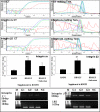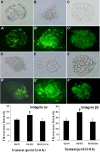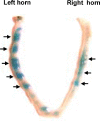Heparin-binding epidermal growth factor (HB-EGF) may improve embryonic development and implantation by increasing vitronectin receptor (integrin alphanubeta3) expression in peri-implantation mouse embryos
- PMID: 16622802
- PMCID: PMC3455038
- DOI: 10.1007/s10815-006-9021-9
Heparin-binding epidermal growth factor (HB-EGF) may improve embryonic development and implantation by increasing vitronectin receptor (integrin alphanubeta3) expression in peri-implantation mouse embryos
Abstract
Purpose: This study investigated the effects of HB-EGF on expression of integrin alphanubeta3 and implantation of embryos.
Methods: Two-cell embryos were recovered and cultured with or without 10 ng/mL HB-EGF for 96h. Expression of integrin alphanubeta3 in cultured embryos was examined by real time-RT-PCR and immunofluorescence analysis; embryos were cultured with or without HB-EGF, then transferred into the uteri of pseudo-pregnant female mice in order to analyze their implantation rate.
Results: HB-EGF improved embryonic hatching and outgrowth during extended culture, and up-regulated expression of integrin alphanubeta3 in both the preimplantation embryo and outgrowing blastocyst. Also, integrin alphanubeta3 subunits were localized at the pericellular borders and cell-cell contact areas. The number of successful implantation sites of transferred HB-EGF-treated embryos in the uterus was increased when compared to number of implantation sites with non-treated controls.
Conclusions: HB-EGF may improve implantation by accelerating expression of integrin alphanubeta3 in peri-implantation mouse embryos.
Figures




Similar articles
-
Improvement of implantation potential in mouse blastocysts derived from IVF by combined treatment with prolactin, epidermal growth factor and 4-hydroxyestradiol.Mol Hum Reprod. 2017 Aug 1;23(8):557-570. doi: 10.1093/molehr/gax035. Mol Hum Reprod. 2017. PMID: 28810691
-
Epidermal growth factor-like ligands and erbB genes in the peri-implantation rabbit uterus and blastocyst.Biol Reprod. 2001 Jun;64(6):1835-44. doi: 10.1095/biolreprod64.6.1835. Biol Reprod. 2001. PMID: 11369616
-
Heparin-binding EGF-like growth factor interacts with mouse blastocysts independently of ErbB1: a possible role for heparan sulfate proteoglycans and ErbB4 in blastocyst implantation.Development. 1999 May;126(9):1997-2005. doi: 10.1242/dev.126.9.1997. Development. 1999. PMID: 10101133
-
HB-EGF: a unique mediator of embryo-uterine interactions during implantation.Exp Cell Res. 2009 Feb 15;315(4):619-26. doi: 10.1016/j.yexcr.2008.07.025. Epub 2008 Aug 3. Exp Cell Res. 2009. PMID: 18708050 Free PMC article. Review.
-
Heparin-binding EGF-like growth factor: a juxtacrine growth factor.Cytokine Growth Factor Rev. 2000 Dec;11(4):335-44. doi: 10.1016/s1359-6101(00)00013-7. Cytokine Growth Factor Rev. 2000. PMID: 10959080 Review.
Cited by
-
Maternal heparin-binding-EGF deficiency limits pregnancy success in mice.Proc Natl Acad Sci U S A. 2007 Nov 13;104(46):18315-20. doi: 10.1073/pnas.0707909104. Epub 2007 Nov 6. Proc Natl Acad Sci U S A. 2007. PMID: 17986609 Free PMC article.
-
Diverse functions of HBEGF during pregnancy.Mol Reprod Dev. 2009 Dec;76(12):1116-27. doi: 10.1002/mrd.21066. Mol Reprod Dev. 2009. PMID: 19565643 Free PMC article. Review.
-
In vitro effects of heparin-binding epidermal growth factor on adhesion stage of implantation.Rom J Morphol Embryol. 2023 Oct-Dec;64(4):493-500. doi: 10.47162/RJME.64.4.05. Rom J Morphol Embryol. 2023. PMID: 38184829 Free PMC article.
-
Melatonin Pretreated Blastocysts along with Calcitonin Administration Improved Implantation by Upregulation of Heparin Binding-Epidermal Growth Factor Expression in Murine Endometrium.Cell J. 2018 Jan;19(4):599-606. doi: 10.22074/cellj.2018.4737. Epub 2017 Nov 4. Cell J. 2018. PMID: 29105394 Free PMC article.
-
Assessment of α4, αv, β1 and β3 integrins expression throughout the implantation window phase in endometrium of a mouse model of polycystic ovarian syndromes.Iran J Reprod Med. 2014 Oct;12(10):687-94. Iran J Reprod Med. 2014. PMID: 25469127 Free PMC article.
References
-
- Das SK, Wang XN, Paria BC, Damm D, Abraham JA, Klagsbrun M, Andrews GK, Dey SK. Heparin-binding EGF-like growth factor gene is induced in the mouse uterus temporally by the blastocyst solely at the site of its apposition: a possible ligand for interaction with blastocyst EGF-receptor in implantation. Development. 1994;120:1071–1083. - PubMed
-
- Paria BC, Elenius K, Klagsbrun M, Dey SK. HB-EGF interacts with mouse blastocysts independently of ErbB1: A possible role for heparin sulfate proteoglycans and ErbB4 in blastocyst implantation. Development. 1999;126:1997–2005. - PubMed
MeSH terms
Substances
LinkOut - more resources
Full Text Sources

